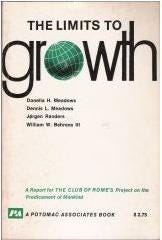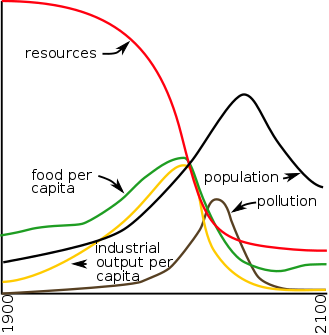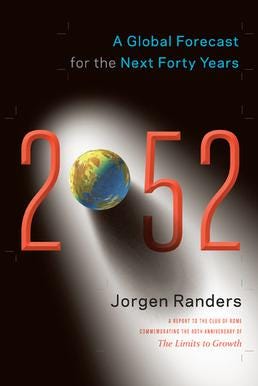 ancient literature, there is always a mention of the end of human civilization, or as we better define it, the end of the world. The literature defines that the end of the world will be caused by some divine power just because they didn’t think that humanity would reach a point in time where they would harm this world as society does now and has done for decades.
ancient literature, there is always a mention of the end of human civilization, or as we better define it, the end of the world. The literature defines that the end of the world will be caused by some divine power just because they didn’t think that humanity would reach a point in time where they would harm this world as society does now and has done for decades.
Although other theories do suggest that whatever or whenever this “end of the world” may come, it will be man-made. The same goes for the software from 50 years ago named “World 3”, created by MIT students to originally predict how the world will look in the future from a statistical perspective. What this first-generation artificial intelligence showed scared the world, but not enough to actually make a drastic change.
Incredible software for its time
The software was developed by a team of environmental researchers from MIT led by Donella Hagaer Meadows who was an Environmental scientist, educator, and writer. World 3 was a development of the original software “World 1 system” created by Jay Wright Forrester known to many as the pioneer of computer engineering from MIT as well as a great system scientist.
One hypothesis of this research was to predict what the future of worldwide growth looked like based on the fact that Earth has limited resources. The researchers tried to see how soon would the world end up chewing through all of the Earth’s resources based on the statistics presented in the western world during the 1970s such as:
- World population growth
- Rate of innovation
- The growth of consumerism
- Usage of resources that don’t regenerate
- Rate of industrial production
- Rate of pollution
- Growth of agriculture
- Other less significant factors
The Club of Rome was the organization that wanted this research to happen and therefore tasked Jay Wright Forrester to create a system that can “predict the future”. The Club of Rome is a private organization formed in 1968 by high-level politicians from around the world whose interest was to predict the future in order to financially capitalize on it, although they promoted that they wanted to see “how the industry will affect the environment”.
The research team was made up of four former students of Jay Wright Forrester. These were the elite of MIT at the time made up of Donella Hagaer Meadows, Dennis Meadows, Jorgen Randers, and William Behrens III.
The frightening results
All of the scientists who participated in this research were excited to see a bright future within the results, but what they saw actually scared them as environmental scientists. The world seemed to reach its peak in all the categories mentioned above in the year 2020!

The results were publicly published in a book written by the four scientists entitled The Limits to Growth which was immediately criticized after being published for presenting inaccurate data and the system used being wrong. This was more of the western societies’ response towards wanting to neglect any possibility of the results being true, but as we can see today they are very close to being true.
A major prediction that was right is the system calculating a variable that was very criticized back in the day. This considered that climate change was caused by humans. The results showed that once the peak is reached, everything will slowly decline, along with the quality of life.
Looking at the results today, it is very strange how the software predicted a peak in 2020, just at the start of the pandemic as if it knew a pandemic would take place.

Factors such as the lack of natural resources, lack of food, or ability to develop agriculture are caused by climate change which is a product of constantly polluting the world for decades.
In this graph, we can see how with the increase of population we have a correlation between the increase of pollution which leads to the decrease of natural resources, food and a major drop of industrial output.
Due to the predicted circumstances, the system averaged that humanity will come to an end near 2040 from various “man-made” events. We cannot really argue with present facts which certainly support the reliability and accuracy of this research.
I presume that we might have a bit longer than the research predicts as people are slowly starting to become more aware of the negative effects of pollution and its overall impact. However, this is happening too slow to make a difference or to keep up with the increasing level of pollution.
Academic work neglected by the Times
Even to this day, this research is considered to be the best in the world of academia, and yet, when the results came out they were criticized by the New York Times as “an empty and misleading work”. This was probably due to even the New York Times being scared of such statements.
ABC News released a short video from 1973, a sort of behind-the-scenes of the whole research and first-hand commentary from the researchers upon seeing the unexpected results.
“What it does for the first time in man’s history on the planet is to look at the world as one system. It shows that Earth cannot sustain the present population and industrial growth for much more than a few decades.” (Quote by Jorgen Randers)
Reconsidering the results
As times have gone by since the publication of the results and contemporary criticisms, people started to give more to this research as the results were becoming more plausible with time and technological advancements. Since its publication over 30 million copies have been sold in over 30 languages.

An updated version was published in 2004 entitled The Limits to Growth: The 30 Year Update by the same authors where they look at how close the results from the first book came to be after 30 years, however, the world lost interest.
In 2012 there was another attempt to awake people to reality with another book entitled 2052: A Global Forecast for the Next Forty Years written only by Jorgen Randers which was trying to develop the ideology that the world will come to an end in the 21st century which will be produced by mankind.
From the look at all of these written analyses, we can definitely expect a global collapse during this century and if you think that this current pandemic was going to be the pinnacle of this century, I would argue that it is only the beginning.
If you want to see some more information I recommend taking a look at the footage presented by ABC News as well as giving one of the books a read.
Avid Writer with invaluable knowledge of Humanity!
Upcoming historian with over 30 million views online.
“You make your own life.”





